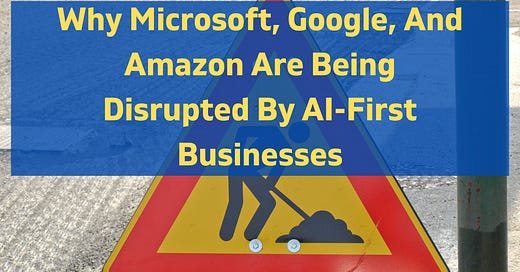Why Microsoft, Google, And Amazon Are Being Disrupted By AI-First Businesses
It's hard to come to terms with the fact that companies like Microsoft, Google, and Amazon are not AI-first businesses. They are all AI leaders, but the business models haven’t transformed to take advantage of the technology. As a result, they are vulnerable to businesses that are built AI-first, or that successfully transform.
AI-first businesses are built to create and monetize AI. Doesn’t Microsoft monetize AI with Copilot? Doesn’t AWS monetize AI by supporting model training workloads and delivering AI services? Surprisingly, the answer is ‘No.’
People pay for Copilot Pro to be more productive using Word, Excel, Power BI, or GitHub. That’s digital-first and AI-enabled. People pay for AWS’s cloud resources, even when building an AI product or using something like Bedrock. That’s cloud-first and AI-enabled. Most companies with AI products are still monetizing them with a legacy technical paradigm.
AI-first requires a business to go all in on AI products and depend upon them to drive 100% of future growth. The same cycle happened with the cloud. Amazon went cloud-first with AWS. It was easier because AWS was built cloud-first from the ground up. For companies like Microsoft, the transformation was much more painful.
Satya Nadella did the difficult work of pivoting Microsoft to become cloud-first. That meant abandoning old products, practices, and monetization strategies. Azure became the center, and everything was built around it or to support it. AWS moved faster because there was no fear of loss or viable business model to hold onto. The result is Amazon’s dominant position in the cloud compared with Microsoft. (I cover this case study more completely in my book.)
In this article, I’ll explain what it means to be AI-first and why AI-first companies have such a massive advantage over incumbents.




